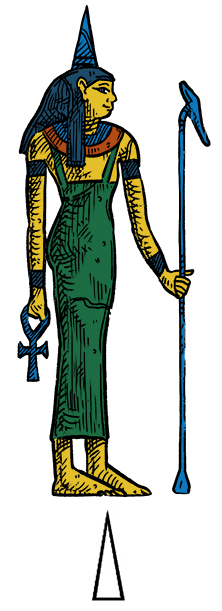Difference between revisions of "Sopdet"
Occultwiki (talk | contribs) |
Occultwiki (talk | contribs) |
||
| Line 6: | Line 6: | ||
The [[Pyramid Texts]] and Coffin Texts both clearly state that the point of their spells is to help the deceased navigate the underworld before joining the stars in the sky as a decan, serving as a crew member guiding [[Ra]]'s solar barque through the body of [[Nut]] each night. The deceased only attains this position as a living, eternal god by being received by Sopdet after completing their trials and following the path up to the heavens. | The [[Pyramid Texts]] and Coffin Texts both clearly state that the point of their spells is to help the deceased navigate the underworld before joining the stars in the sky as a decan, serving as a crew member guiding [[Ra]]'s solar barque through the body of [[Nut]] each night. The deceased only attains this position as a living, eternal god by being received by Sopdet after completing their trials and following the path up to the heavens. | ||
Sopdet's consort was the god [[Sah]]. | |||
==Depiction== | ==Depiction== | ||
Revision as of 18:39, 9 August 2023
Sopdet is the 36th decan of the main decanal stars of Egyptian astrology. The decan has its heliacal rise during the week of IV Shemu 21-30 in the Egyptian calendar.
Religious background
The Egyptians based their entire calendar on the heliacal rise of the star Sirius, which was considered to be the goddess Sopdet herself. This established Sopdet as one of the most important deities in the Egyptian religion throughout all time periods.
The Pyramid Texts and Coffin Texts both clearly state that the point of their spells is to help the deceased navigate the underworld before joining the stars in the sky as a decan, serving as a crew member guiding Ra's solar barque through the body of Nut each night. The deceased only attains this position as a living, eternal god by being received by Sopdet after completing their trials and following the path up to the heavens.
Sopdet's consort was the god Sah.
Depiction
The hieroglyphic symbol for Sopdet is a pyramid; and on the Middle Kingdom Period coffins, the goddess is depicted as a woman holding a wAs scepter with a pyramid on her head.
Divination meaning
The Egyptian Star Oracle connects this decan with inundation.
Characteristics
In ritual work, Sopdet may be evoked for any of her various traits and powers, or even as a symbol of feminine energy. The Naos of the Decades says that Sopdet has power over life and death: the sky, the earth, and the Duat follow her instructions.
On the Dendera D zodiac, this decan's mineral is listed as gold.
| The Decans of Egyptian Astrology | ||
|---|---|---|
| Previous Decan | This Decan | Next Decan |
| Tepy-a Sopdet | Sopdet | Shetwy |
